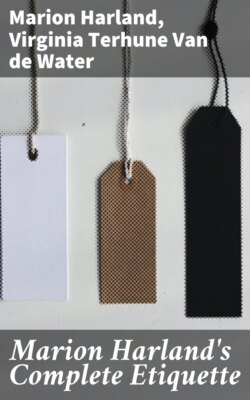Читать книгу Marion Harland's Complete Etiquette - Marion Harland - Страница 6
На сайте Литреса книга снята с продажи.
CHAPTER IV
INTRODUCTIONS
ОглавлениеTable of Contents
THIS matter of introductions is one rather too lightly considered on our free American soil. Unless the social exigencies are such as to make the atmosphere formal and unpleasant if people are unknown to each other, it is taking a liberty to present a man to a woman without first and privately asking her permission. It is a woman’s privilege to decline or to accept masculine acquaintance as she chooses. If she grants permission for the introduction, the person who has asked such permission brings the man in question to her and says: “Miss A., may I have the pleasure of presenting Mr. B. to you?” We have all been witnesses at some time or other of that most unconventional performance where the woman in the case allows herself to be dragged across the floor to the man concerned. We have all, on occasion, heard the proper form so twisted as to make the woman the person presented instead of the man. This is the worst sort of no-form. The social convention prescribes that the man shall take the initiative in requesting the introduction, that he shall seek the lady, that he shall be the person presented.
INTRODUCING ONE’S HUSBAND
An American woman in presenting her husband will usually say, “My husband, Mr. Smith.” An English woman would be more formal. She would say simply, “Mr. Smith.” When a man is presented to a woman, if she is seated she need not rise but may merely bow. In case the man is distinguished or elderly or if he be a warm friend of her husband, or her guest, she will rise and shake hands.
Never awkwardly drag a newcomer around to every person in a large circle. Introduce him to several of those nearest and later such further introductions as are desirable will naturally follow. When the group includes a half-dozen only, it is necessary to introduce all round. In this case the ceremony may be gracefully shortened by repeating two or three names together, thus: “Mrs. Brown, Mrs. Smith, may I present Mr. James?”
Never introduce your sister or your daughter, if she be grown, merely as such. The other person will be confused, not knowing whether the one introduced is married or single, and hence in doubt as to what name to use.
CLERICAL INTRODUCTIONS
At a reception given to an archbishop of the Roman Catholic church, it is customary for devout Catholics to kiss the ring but Protestants may merely shake hands. A cardinal ranks as a prince of the Roman Catholic church and is addressed as “His Eminence.” Women as well as men are presented to him, not he to them. A woman is also presented to a bishop.
When two women of about equal age and importance are to be introduced merely mention the two names, thus: “Mrs. A., Mrs. B.” The general rule in all introductions is to present the woman to the man, the young man or young woman to the elderly, the unmarried woman to the matron, when of about the same age. One may say “May I present” or with two men of near the same age, “I want you to know.” Never say, “Let me make you acquainted with.” That is provincial.
ADDRESSING THE QUEEN
The American who goes abroad expecting to be presented at court must, of course, acquaint himself with the etiquette of that court. He will receive such advice as he needs from his ambassador but it may be useful for him to know ahead of time some of the things that are required of him, or more precisely of her, for court presentations are much more coveted and sought after by American women than by men. However, it is understood that a man whose wife has been presented is himself eligible to attend the king’s next reception for gentlemen only. The English queen is addressed simply as “Ma’am” by all Americans who have the honor of presentation. King George would be addressed as “Sir.” The Prince of Wales is “Prince” and his wife “Princess.” The phrase “Your Majesty” is reserved for use by the lower English classes. An American, by virtue of his having no rank at all, takes rank with the highest when he is introduced at court. A duke is addressed simply as “Duke,” and a marquis by his title, “Lord ——.” The daughters of dukes, marquises and earls must be given their Christian names, as “Lady Mary Towers.” The sons should be addressed as “Lord John Towers,” “Lord Henry Towers.” An archbishop is properly addressed as “Your Grace” or “My Lord,” but his wife is plain “Mrs. ——.” Members of foreign royal families have the title of “Prince” and “Princess.”
A baron visiting in this country would be presented to the American ladies he meets quite like any other gentleman, and his wife would not take precedence of them unless she happened to be elderly.
When in a friend’s house one should bear in mind that introductions are the natural prerogative of the host and the hostess. One should not, however, allow an awkward situation to develop from a too rigid observance of this rule.
PROFESSIONAL MEN
Remember that many professional men do not like to be called “Professor” because of the cheap ways in which this title has in recent years been used. By a little tact in individual instances one can learn which is preferred—“Professor,” or “Mr.,” or “Doctor,” if the person in question be entitled to that distinction.
In making introductions a clever man or woman often adds a word of comment that will help the two meeting to start their acquaintance on a friendly and intelligent basis.
